Luxury Clothing Market Report (2025 to 2030): Trends & Insights
The global luxury clothing market is poised to hit $364.4 billion by 2030, up from $274.8 billion in 2025, growing at a steady CAGR of 5.8%. But this growth comes with a shift in dynamics. The ultra-rich buyers, who are responsible for up to 40% of total spending in the luxury market, are starting to redirect money toward experiences, travel, and home upgrades.
The second-hand luxury segment is growing at twice the pace of the overall market and is projected to reach $66.1 billion by 2030. In this post, we break down where the growth is coming from, who’s driving it, and how the luxury clothing space is evolving across different regions and age groups.
Luxury Clothing Market Size 2025 to 2030
The luxury clothing market is valued at $274.8 billion as of 2025 and is estimated to reach $325.4 billion by 2028 and $364.4 billion by 2030, growing at a CAGR of 5.8%.
North America and Europe are the biggest markets for luxury clothing and will continue to dominate the sector for years to come.
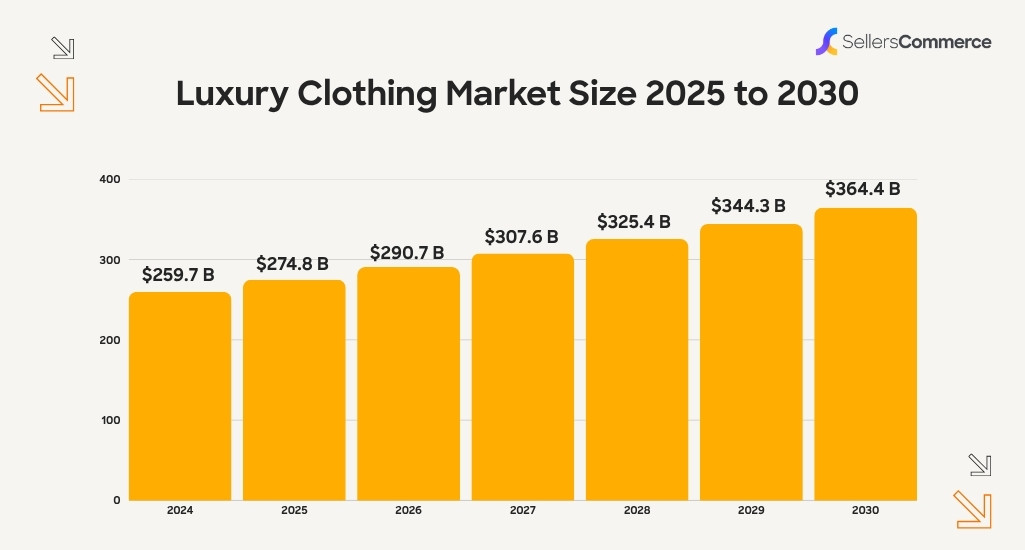
| Year | Luxury Clothing Market Size |
|---|---|
| 2024 | $259.7 billion |
| 2025 | $274.8 billion |
| 2026 | $290.7 billion |
| 2027 | $307.6 billion |
| 2028 | $325.4 billion |
| 2029 | $344.3 billion |
| 2030 | $364.4 billion |
Source: Staritsresearch.
A Note On Growth Drivers Of Luxury Items In Different World Regions
United States
Spending power among aspirational middle- and upper-class consumers is rising, helped by easing inflation, higher disposable income, and a strong real estate market.
Additionally, the ultra-high-net-worth (UHNW) population continues to grow, expanding by 8% in 2023 and projected to grow by 5% annually from 2023 to 2028.
Europe
Luxury demand within Europe remains soft as local consumers continue to spend cautiously. However, international tourism is helping offset this. As of May 2024, tax-free shopping in continental Europe had reached 138% of pre-COVID levels.
Although spending by Chinese tourists was still at 59% of 2019 levels, foreign tourist arrivals are expected to grow by 8% annually between 2024 and 2026, which will likely support further market growth.
China
China’s luxury market is expected to recover slightly in late 2025, supported by a high household savings rate of 32% and the emergence of new wealth hubs like Shenzhen and Wuhan. However, overall domestic growth may stay below past trends due to increased international travel and a slower rise in UHNW individuals, 8% annual growth projected from 2023 to 2028, down from 13% between 2019 and 2023.
Why Consumers in the USA Buy Luxury Products
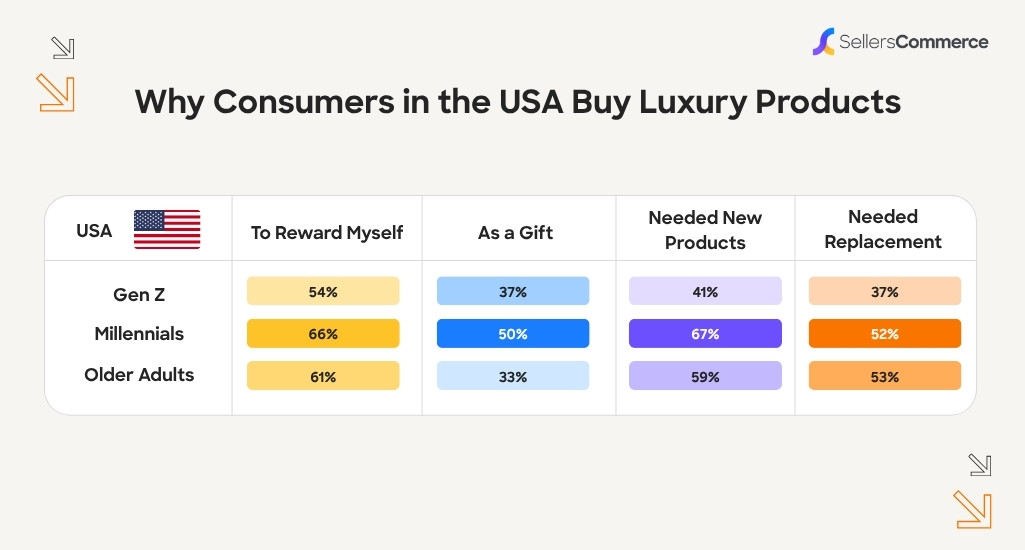
Here is a table showing the United States’ biggest fast fashion brands.
| Age Group | To Reward Myself | As a Gift | Needed New Products | Needed Replacement |
|---|---|---|---|---|
| Gen Z | 54% | 37% | 41% | 37% |
| Millennials | 66% | 50% | 67% | 52% |
| Older Adults | 61% | 33% | 59% | 53% |
In the United States, Millennials are the most driven group when it comes to luxury purchases across nearly all motivations. Two-thirds of Millennials buy luxury items to reward themselves, and more than half say it’s because they need new products or are replacing old ones.
Gen Z, on the other hand, is less motivated by necessity or gifting and leans slightly more toward self-reward, with 54% citing it as their main reason.
Older adults also show strong self-reward tendencies (61%), but they’re less likely to buy luxury as gifts (only 33%) compared to Millennials (50%).
The need for new or replacement products becomes more relevant with age, especially for older adults who show high percentages in both categories—59% and 53% respectively. Overall, personal satisfaction and utility are bigger drivers than gifting when it comes to luxury shopping in the U.S.
Source: Kearney.
Demographics of US Luxury Clothing Shoppers
Gen Z makes up around 20% of the U.S. population and holds about $360 billion in disposable income as of 2025. Their strong spending power shows in their luxury shopping habits too as 53% of Gen Z are passionate luxury buyers. This is much higher compared to 39% of Gen X and just 25% of Boomers.
Older shoppers usually go for classic luxury items such as watches, handbags, and coats. In contrast, younger, wealthier consumers prefer more relaxed and casual products, their top luxury picks include sneakers, hoodies, and fragrances.
Source: GWI USA.
Millennials and Gen Z Prefer Experiences Over Products
More than 75% of millennials would rather spend money on experiences than on physical products, according to a report by Eventbrite. On a global scale, 56% of both millennials and Gen Z say that prioritizing experiences over material things is important in their personal lives. This shift in values is shaping how luxury brands market and design their offerings.
Source: Sotheby’s Institute.
Ultra-Rich Customers Drive Most of the Luxury Market Growth
Ultra-high net worth individuals make up just 2% to 4% of luxury buyers but are responsible for 30% to 40% of total spending. Between 2023 and 2027, they are expected to contribute 65% to 80% of the luxury market’s growth.
However, many in this group plan to reduce spending on personal luxury goods. Instead, they are shifting their focus to home decor, travel, and hospitality. According to McKinsey, a common reason is that they feel they have overconsumed since the pandemic.
Source: Fashion Dive.
Spending Patterns Of US And Chinese Luxury Consumers
In 2024, the US luxury market showed resilience with a growth rate of 1% to 3%. Looking ahead, it is expected to grow faster, reaching 3% to 5% in 2025 and 4% to 6% between 2025 and 2027.
In contrast, China’s luxury market contracted sharply in 2024, with a decline of 5% to 7%. It is expected to stabilize in 2025 with flat to slight growth between -3% and 0%, before recovering to 3% to 5% growth from 2025 to 2027.
Source: Kearney.
The Luxury Industry’s Economic Profit Is Predicted To Slow Down
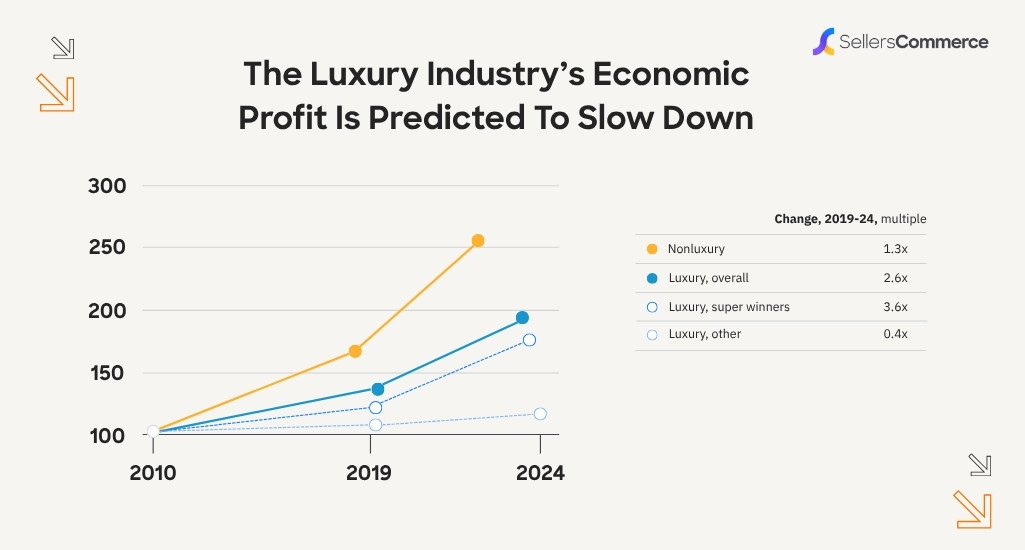
The luxury industry’s economic profit almost tripled between 2019 and 2024. But as we enter 2025, the industry is slowing down sharply. For the first time since 2016 (excluding the pandemic year 2020), the luxury sector is expected to create less value than it did the year before.
Several key growth drivers are no longer working. Brands have pushed prices up as far as they can, and now higher prices are turning away aspirational luxury buyers. On top of that, global economic challenges, especially in China, a market that added over 18 percent growth per year from 2019 to 2023, are putting extra pressure on the industry.
Source: McKinsey.
Luxury Market To See Slower Growth From 2025 Onwards
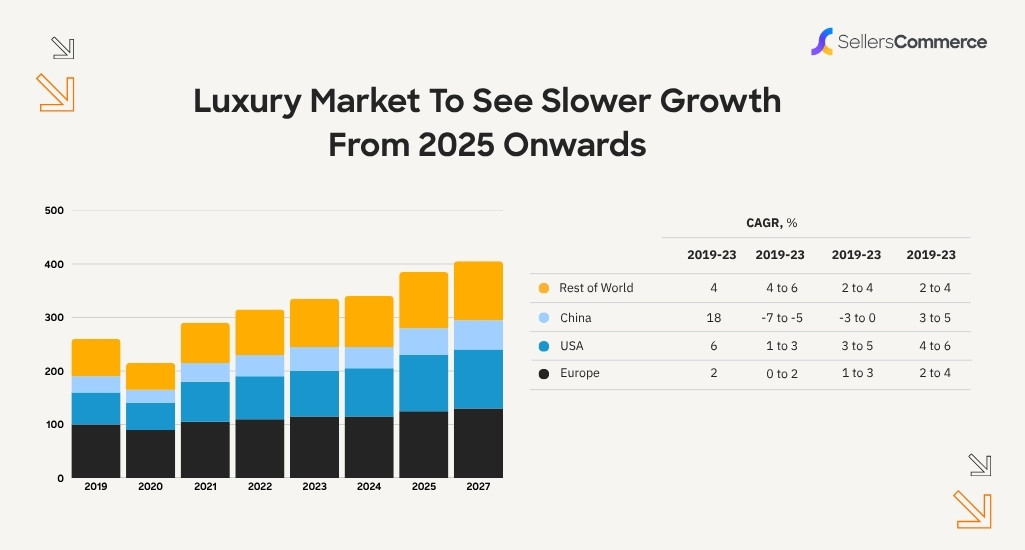
The global luxury market saw strong momentum between 2019 and 2023, but growth took a sharp dip in 2024. The slowdown is visible across major regions, especially in China, which shifted from being the fastest-growing market to posting negative growth in 2024. From a strong 18% annual growth between 2019 and 2023, China saw a contraction of around 5% to 7% in 2024, with only slight recovery expected in 2025.
The United States showed better stability. After modest growth of 1% to 3% in 2024, it is expected to grow at a healthier 4% to 6% pace between 2025 and 2027. Europe, which includes Russia, remained largely flat in 2024 but is also expected to pick up gradually. The “rest of world” segment, which includes other countries, stayed steady, posting growth between 2% and 6% across the forecast years.
While the luxury sector as a whole is still expanding, the pace has clearly slowed and is expected to remain moderate in the near future. Recovery will depend heavily on how China rebounds and how consumer spending holds up in other regions.
Source: Mckinsey.
Second-Hand Luxury Clothing Market Size 2025 to 2030
The second-hand luxury clothing market is valued at $41.6 billion as of 2025 and is estimated to reach $55.4 billion by 2028 and $66.1 billion by 2030, growing at a CAGR of 10%.
The second-hand luxury clothing market accounts for 15.1% of the global luxury clothing market and is growing at twice the overall market rate.
| Year | Second-Hand Luxury Market Size |
|---|---|
| 2023 | $34.4 billion |
| 2024 | $37.8 billion |
| 2025 | $41.6 billion |
| 2026 | $45.8 billion |
| 2027 | $50.3 billion |
| 2028 | $55.4 billion |
| 2029 | $60.5 billion |
| 2030 | $66.1 billion |
Source: Businesswire.
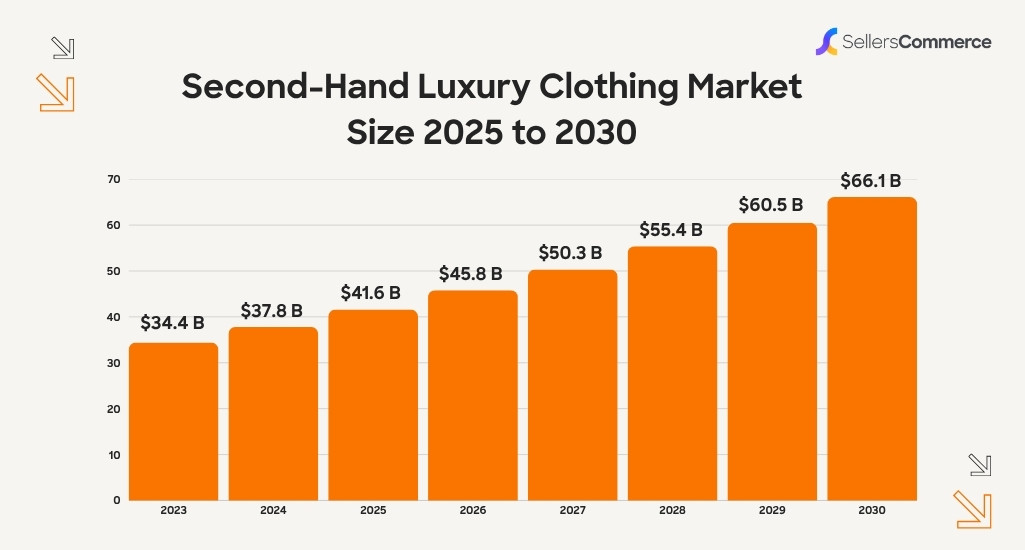
Luxury Resale Gains Ground, But Trust Remains A Concern
20% of online conversations about luxury resale focus on finding trustworthy platforms that guarantee authenticity. Another 25% highlight the appeal of unique and historical value in secondhand luxury, while 24% center around the affordability and accessibility of pre-owned items.
Source: McKinsey.
Additional Insights On The Luxury Clothing Market Around The Globe
- Japan’s luxury boom is expected to continue into 2025, fuelled by strong international and domestic spending. Japan’s luxury market grew 25% to 30% in the first half of 2024, driven by ongoing currency weakness and a surge in tourism
- 63% of fashion executives believe APAC mature countries have promising growth prospects in 2025
- Chinese luxury spending abroad is projected to increase by 12 to 17% points from 2023 to 2025
- Aspirational customers, who make up about half of global luxury sales in India, are expected to grow from 60 million in 2023 to 100 million in 2027.
Ready to launch your next
Employee Program?
Uniform Programs?
Company Stores?
Group Stores?
Team Stores?
Swag Stores?
Brand Stores?
Event Stores?
Distributor Portals?
Enabling uniforms and promotional product suppliers with eCommerce solutions to manage B2B, B2B2C, and Direct selling from one central platform.

